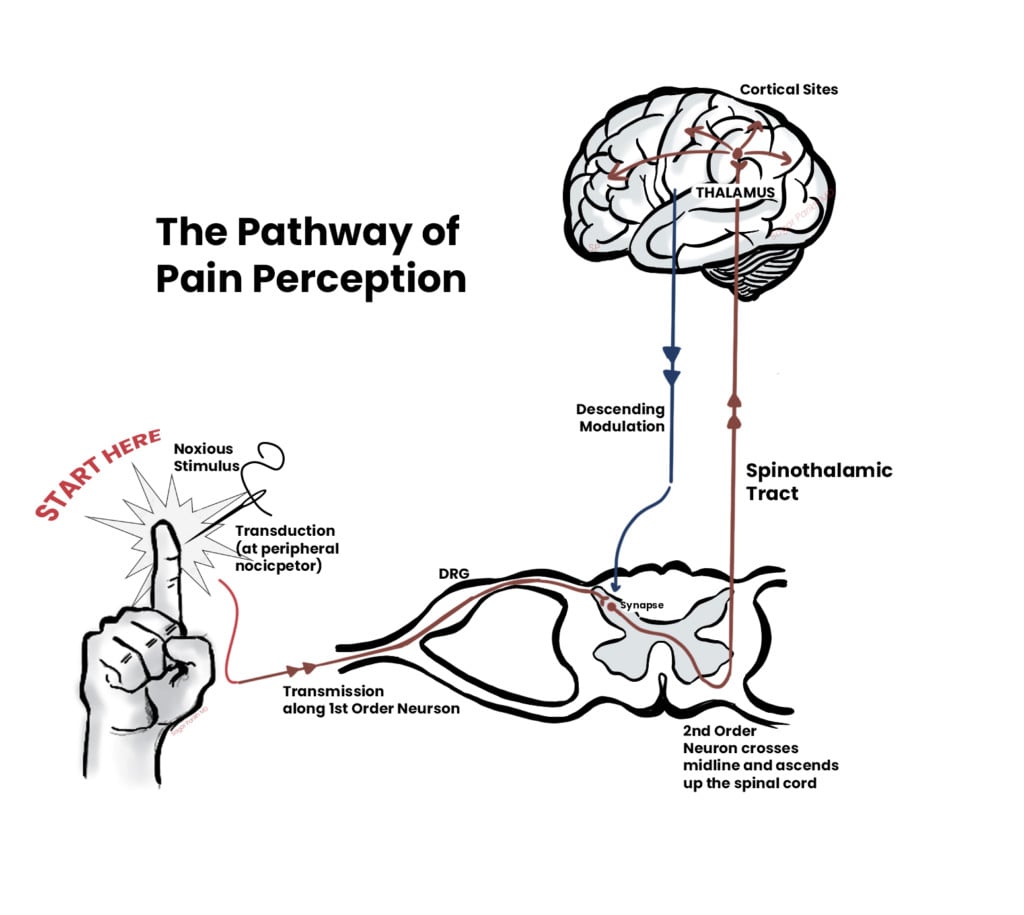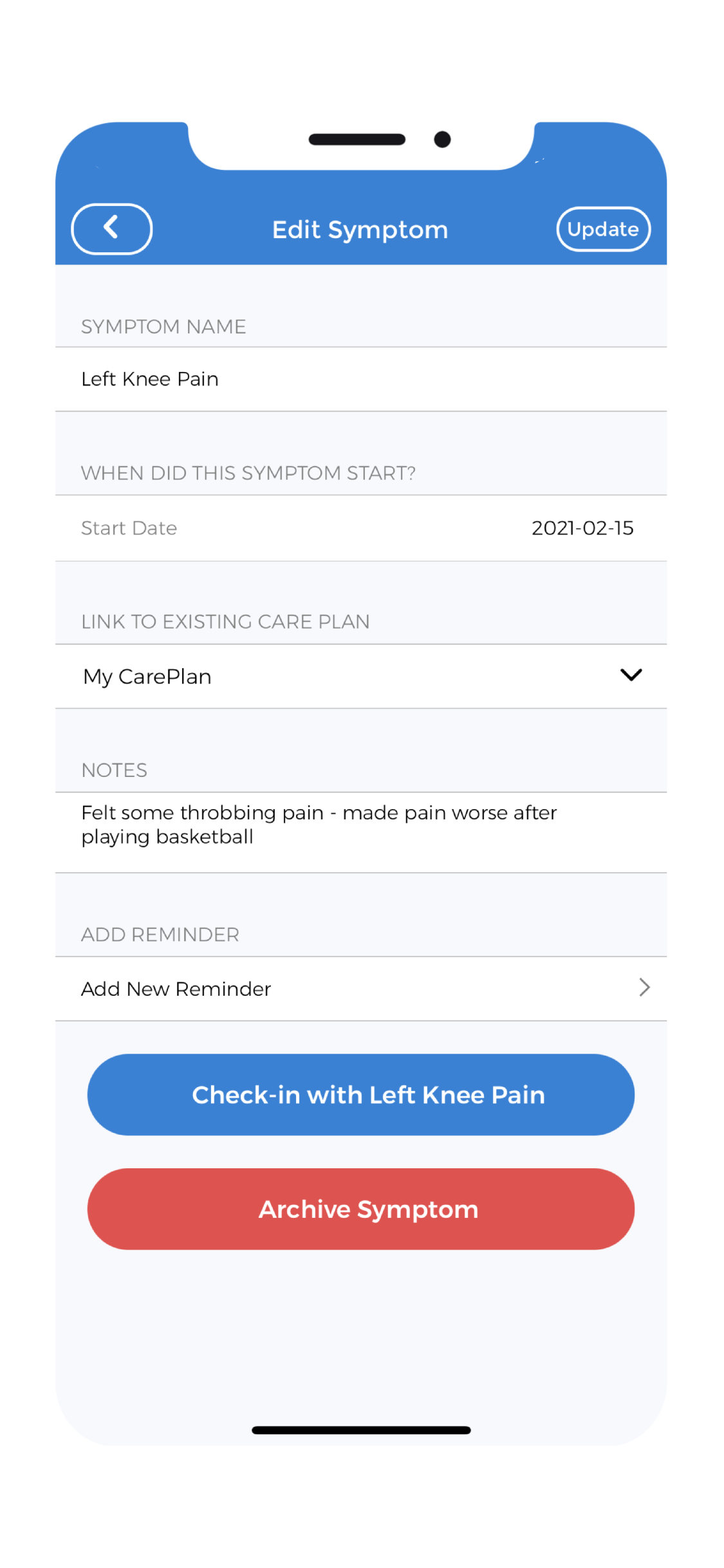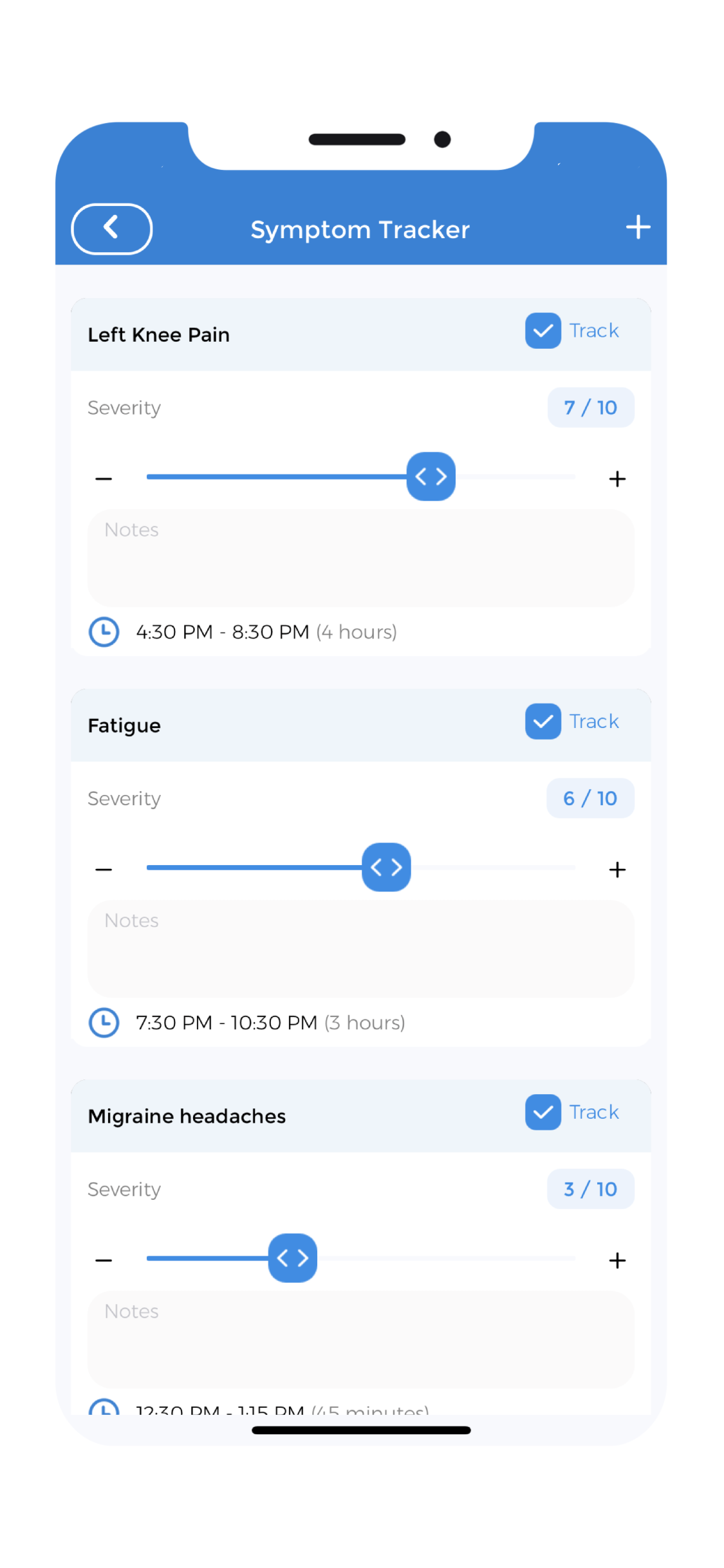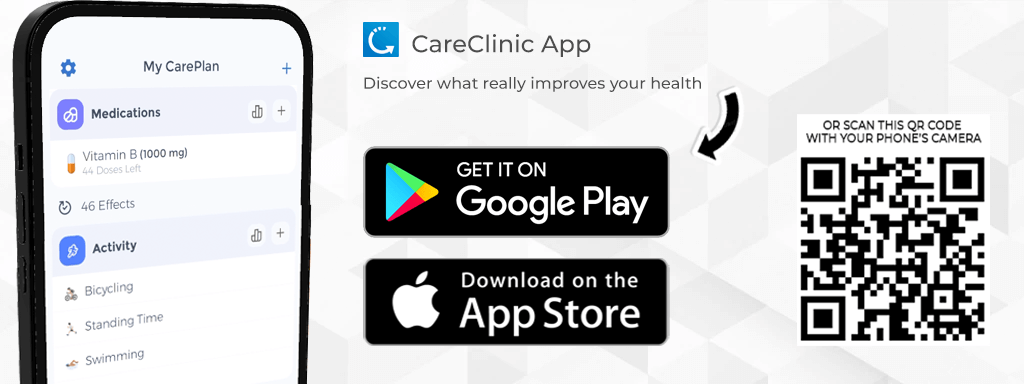
We experience pain both physically and emotionally – it is not pleasant and is due to a perception of real or potential damage to our bodies. All pain is perceived and processed by your brain. Pain is your body’s warning system alerting you to harm. The pain signals travel through your nerves, up your spinal cord to your brain. Becoming familiar with techniques for managing pain can be very useful. What are some of the best ways to manage pain?
What is pain?
We feel pain when specific sensory nerves in our body called nociceptors detect tissue damage and transmit this information via the spinal cord to the brain.
Here is an example to explain the neural pathway that pain messages take in the body. When cooking in the kitchen, you accidentally touch the hot surface of the water heater, stovetop, or cup. This instantly causes a signal to be sent to the spinal cord via a reflex arc.
This subsequently causes an instant contraction of the muscles in our hands and arms so that we pull away very quickly from the hot surface. This instinctive reflex prevents us from further tissue damage in our hands. Usually, this reaction is done so quickly that the message has not yet reached the brain. This is why we may experience a momentary delay until we experience the sensation of pain in our brains.
Your brain then interprets the pain signal based on its intensity and location, as well as a variety of other information such as your surroundings, previous injury experience, your beliefs, your emotional state, and many other factors. You feel the pain after your brain has processed all of this information.
Experiences of pain
You may feel pain differently from everyone else. This can occur even when people have the same disease or injury as you. Just like your experience with arthritis can be very different from someone else’s, the same goes for the pain you experience. This also means that pain treatments, such as medications and other interventions, that work for one person may not work for you, or may work differently.
There is also a strong mind-body connection. Your emotions and thoughts play a large role in how you experience pain, and pain can affect all aspects of your life
People feel the sensation of pain when signals travel through the body’s nerve fibers toward the brain for interpretation. We each may experience pain differently and in a variety of different ways.
Pain can be long-term pain or short-term. Pain can also be limited to one area or it could spread across the body. Furthermore, pain could feel like anything from a dull ache to a sharp burning sensation. Pain management techniques can be extremely useful to patients who are experiencing consistent pain that is interfering with their daily activities.

Acute vs. chronic pain
Pain can be divided into a few types, but generally, it is categorized as acute or chronic. It is important to know which type of pain you are experiencing in order to utilize the appropriate techniques for managing pain.
 Chronic pain
Chronic pain
Chronic pain lasts far longer than acute pain and there is often no cure. This pain can be mild and or it can be severe and at times, continuous. For example, arthritis is a continuous feeling of pain whereas migraines is a feeling of intermittent pain. Migraines occur repeatedly but they stop in between. The main difference between chronic pain and acute pain is that fight-or-flight reactions eventually stop with people experiencing chronic pain. This is because their nervous system eventually adapts to the pain stimulus.
Chronic pain is also called persistent pain. People who live with chronic diseases often live with chronic pain as well. This type of pain does not necessarily mean that damage is occurring – even though it might feel that way. While chronic pain is not fully understood, we know that it is sometimes caused by a problem with one or more nerves and the way they send pain messages to the brain.
Acute pain
Acute pain refers to intense and short-lived pain. This goes back to the example of touching a hot coffee cup which involves activating a reflex arc. This acute pain usually triggers our body’s fight or flight mechanism. Acute pain divides into different types of pain as described below:
- Somatic pain: The person feels superficial pain on the skin and or soft tissue just below the skin.
- Visceral pain: This pain emerges from the internal organs and the linings of cavities within the body.
- Referred pain: Referred pain is when a person feels pain at any location other than the source of the damage. For example, people often report shoulder pain when they experience a heart attack.
- Managing anger deriving from pain and disappointment can be a difficult process. It is important to take time to recognize, accept and validate your feelings in order to begin the healing process. Developing an understanding of what has caused you to become angry can help you work through it in a more constructive way.
Acknowledging the source of the anger and recognizing when it is impacting your life in an unhealthy way can be the first step to managing it. Recognize when anger is surfacing, take a deep breath and count to ten or take a time-out away from any situation that is triggering the feeling of anger.
Sometimes, when there are lots of cases of acute pain, this can create a build-up of signals within the body’s central nervous system. This can lead to overstimulation and usage of the nerve fibers. The result of this is feeling pain for longer than a person would.
Managing pain
There are many techniques for managing pain. Pacing yourself and your activities and tracking how you feel from day to day will help you learn to understand your pain. These approaches and tips will help you maintain a schedule so you can better predict what your days with pain will feel like.
Treatment for acute pain
Acute pain treatment generally includes taking some form of medication. This will depend on the recommendation and advice of your doctor and trained medical professionals. Examples of such treatment medication for acute pain are described below.
Non-steroidal Anti-Inflammatories (NSAIDs)
Analgesics or pain reliever medications can be very beneficial for patients who find nonpharmacological pain management to be ineffective for them. This form of medication can usually help treat pain and help a person regain their daily function. NSAIDs can be accessed over the counter or via prescription. They have a wide range of strengths. NSAIDs are suitable for treating minor acute pains. This includes but is not limited to: headaches, sprains and back aches.
NSAIDs can also help with relieving local inflammation, pain due to swelling and other similar traumas to the body. However, when NSAIDs are taken at higher dosages, they may lead to side effects. It has been reported that NSAIDs can result in digestive system effects, including bleeding. Therefore, it is important for doctors and their patients to monitor their dosage.
Ensure that you read the packaging to check that you are taking the correct analgesic and consuming the appropriate dosage. The best way to monitor the dosage would also be through personal monitoring of dosage quantity with CareClinic. You can use the app to set reminders for taking your medications and check in with the app each time to take your medication. This helps to make sure you are taking your daily medications at the appropriate time and dosage.
Managing Conditions like Rheumatoid Arthritis
Rheumatoid arthritis can cause pain and inflammation in the joints, muscles, and other areas of the body. Managing this pain may be similar to managing pain for other types of arthritis and chronic pain. Here are a few things that work best: Exercise: Regular, gentle exercise can help reduce pain and stiffness. Low-impact exercises such as walking, swimming, or cycling are good options. Talk to your doctor before beginning an exercise program to be sure it is right for you
Heat and Cold Therapy: Applying heat or cold to the affected area can help ease discomfort. Ice packs can help reduce inflammation and swelling, while heating pads or warm water baths can relax muscles and improve circulation. Pain Medication: Over-the-counter pain medications such as ibuprofen or acetaminophen may be helpful in relieving mild to moderate symptoms. If you notice your pain worsen or experience any side effects, talk to your doctor about alternative treatments. Stronger prescription medications may be necessary for more extreme cases of pain.
Manage chronic pain
There are a large number of non-drug therapies that can help with the relief of chronic pain. Natural alternatives to medication for chronic pain management is important. Nonpharmacological pain management can be highly effective as chronic pain usually does not subside like acute pain does. Examples of nonpharmacological pain management therapies include the following:
- Relaxation Therapies: Relaxation therapies include a large number of varying relaxation techniques and exercises. The majority of these exist outside of traditional medication. People undergoing relaxation therapies may choose to engage in hypnosis, yoga, massage therapy, tai-chi and others.
- Virtual Reality Methods: There is a new and emerging trend of utilizing virtual therapy settings in order to help patients cope with chronic pain. This usually revolves around creating a serene environment and letting patients freely wander in this virtual environment. The goal is to allow patients to free the minds of their chronic pain.
- Psychotherapies: This form of therapy usually involves having sessions with a psychotherapist. The psychotherapist helps patients improve their understanding of pain. After gaining this understanding, the psychotherapist works with the patient to implement changes into their lifestyle. The changes aim to minimize pain intensity and build up pain resistance skills.
- Physical Manipulation and stretching: Sometimes physiotherapists and/or chiropractors can help people relieve pain by manipulating tension from muscles within the body through the application of physical exercise and stretches
- Rest and repair: Chronic pain is sometimes due to a certain injury or consistently overworking a part of one’s body. At times, rest might be the best option to treat chronic pain.
Exercise can help to block pain signals by releasing endorphins and other neurotransmitters, such as serotonin and dopamine. Endorphins are the body’s natural pain relievers, which work to block out pain signals from reaching the brain. Other neurotransmitters can also activate pain-relieving receptors in the brain, helping to further block out pain signals.
Regular exercise has been proven to increase the release of these neurotransmitters, providing an effective way to reduce chronic pain sensations. In addition, exercise can help improve physical and mental wellbeing, which can further reduce the intensity of chronic pain symptoms. Finally, regular exercise is known to have positive effects on joint mobility and flexibility, as well as muscle strength, which can help reduce pain in areas affected by stiff, inflexible muscles.
All of these effects make exercise an effective form of managing chronic pain. This is why sometimes you may notice that if you sit idle and do not do much at home for extended periods of time, you feel like “things are breaking down a lot more” in your body than when you were (ironically) more physically active. You may use the CareClinic app to discover correlations between your physical activity and pain in the app.
What is progressive muscle relaxation?
Progressive muscle relaxation (PMR) is a technique of tensing and then relaxing the muscles in different parts of your body. It helps to reduce stress and increase relaxation by focusing on the physical sensations associated with each muscle group. This practice can be done anywhere, at any time, for a few minutes or longer. The goal of PMR is to become aware of tension in the body and learn how to relax it quickly through mindful breathing and visualization techniques.
To do progressive muscle relaxation, you start by tensing up a particular muscle group – such as your shoulders, arms, or legs – while taking deep breaths and counting to 10. Then you slowly let go of the tension while consciously focusing on the feeling of release in that area. You repeat this process for each muscle group, moving from the top of your body to the bottom. After several minutes of practice, you should feel calmer and more relaxed overall.
PMR can also help improve sleep quality by calming down the body and mind. Even if you don’t have time for a full PMR session, simply taking a few moments to focus on your breathing and scan your body for areas of tension can do wonders in reducing stress levels. With regular practice, progressive muscle relaxation can be an effective tool for managing anxiety and improving mental well-being.
Physical Therapy for Persistent Pain
Physical therapy can be a helpful form of treatment for persistent pain. Physical therapy is a type of treatment that focuses on improving physical health, strength, and flexibility through therapeutic exercises and manual techniques. These therapies can help reduce pain, improve movement, and restore function by increasing the range of motion in the affected area.
In many cases, physical therapists will work with other specialists to create an individualized plan that best meets your needs. They may suggest stretching exercises to increase flexibility; strength training programs to build endurance, or aquatic therapy programs to relax muscles while increasing mobility in joint movements. In addition, they may use manual techniques such as massage or myofascial release to reduce tension in the soft tissues surrounding joints. Other treatments include ice and heat therapy, electrical stimulation, and ultrasound.
These modalities can be used to reduce inflammation and relieve pain. Many of these therapies are already loaded into the Therapy tracker within the CareClinic app to monitor your effectiveness with them. This will also help your physio determine the efficacy of your treatment based on your adherence.
Benefits of monitoring your pain
Pain is a complex symptom and one that can reveal valuable information about your health status. When you use a health app such as CareClinic to track your pain, you are gathering information about its intensity, frequency and potential triggers. The more you and your care team know about your pain, the easier it will be to address the underlying issue.
By keeping a diary of your pain, you might be able to discover if stress, sleep deprivation or changes in weather patterns have contributed to your symptoms. You can track all of the things that might impact your pain and get an understanding of potential triggers. As a result, you can try different solutions to cope with the pain or eliminate it altogether.
Regular monitoring through the pain log is beneficial from another perspective as well. The CareClinic health app will offer you monthly reports, which are created in accordance to your entries. You can print the report or opt for the pain log PDF version, sharing your information with the doctor.
Together, you can find the most suitable treatments and intervention solutions, obtaining the necessary pain relief and improving your overall quality of life.
Managing pain with the CareClinic app
CareClinic can easily keep track of pain in a log format through regular entries.
The app is available on both iOS and Android, it is simple to use and it guarantees the faithful recording of our pain-related information. Here are steps for using CareClinic to track your pain:
- Create My Care Plan
- Add goals to achieve with your plan
- Add medication & supplements for pain relief
- You can invite friends or family members to be part of your care team
The care plan should include information about your medication, dosage, and frequency, as well as details on various therapies, activities, nutrition, etc. You can add notes for all of these so that you can get a better overview of what works and what is not suited to your condition.
If you are taking medication for pain management, you can set up reminders to ensure that you adhere to your medication regime. You can view the reminders in the calendar and use this feature for doctor appointments as well.
Adding symptoms to the pain management log is also very simple. As soon as you have experienced pain, you can log the respective symptom into the CareClinic app. You can also mention when the symptom started and how long it took to stop. You can add notes directly, and connect your entries to the existent health conditions. The application allows you to record multiple symptoms and even different types of pain.
Sharing pain logs with your healthcare team
At the end of each month, the CareClinic application can issue a report containing a detailed analysis of your pain and underlying conditions. Your physician can review the medication log and make adjustments to your treatment if necessary.
One can export the CareClinic health report from the application as a PDF document (or printed) and share it with their physician. The physician can analyze the reports and logs, looking for triggers and patterns that make the pain worse. Your pain diary will offer a consistent record of your pain experience and the more detailed you are in your entries, the easier it will be for the physician to come up with the best treatment solutions.
It is always a good idea to be honest about how the pain feels. Use the CareClinic health diary to record what makes the pain better, such as medication or changing positions. Make sure to mention what makes it worse or provokes it, such as movement or specific positions. Your doctor can take your information and come with a treatment plan that is suited to your current condition.
What should you track in your log for managing pain?
We can classify pain as localized, diffuse or generalized. It can appear on its own or in relation to various activities. The location of the pain can guide one toward a specific diagnosis; for example, if you suffer from liver disease, you might experience pain in the upper right side of the abdomen.
from liver disease, you might experience pain in the upper right side of the abdomen.
You can record the pain experienced according to the location. For example, you might present lower back pain, pain in the ribs or headaches. With headaches, things are even more complicated, in the sense that there are different types that can bother you (tension headaches, migraines, cluster headaches). Keeping a record of this can help you with managing pain.
The most common types of pain include muscle and joint pain, arthritis pain, back pain, stomach pain, neck pain, shoulder pain, TMJ pain, abdominal pain, chest pain, hip pain, nerve pain and so on. Several different types of pain might be present, requiring a multidisciplinary approach for pain relief to occur.
Each person will experience pain in his/her own way. Moreover, we each have different levels of tolerance to pain. This is the main reason for requiring an adapted intervention plan. New pains might appear on top of the existent symptoms, so it is essential to take potential changes that can occur into consideration.
CareClinic, a free app for managing pain
A health diary app such as CareClinic is quite helpful for those who live with chronic pain. Aside from adding information to the pain log sheet, one can keep track of additional factors influencing the symptom, such as stress, mood, nutrition, physical activity, and so on. Tracking symptoms and medications on the CareClinic platform can help with managing pain.
The application will help you make connections between various activities, events and weather changes, and the flare-ups of the pain syndrome. One will no longer feel alone or unsupported, as the application can provide guidance with regard to the long journey toward recovery or improvement. The more one will know about his/her condition, the more he/she will feel in control and thus be able to manage the existent pain in an effective manner.
The simple-to-use measurement input methods allow for patients to easily check-in with the app daily. Their care team is also able to communicate with patients through the app. The app notifies doctors so they stay up to date with their patients 24/7.
Patients are also able to keep track of exactly how they are feeling and trace the source of their pain better through using the app. No longer do patients have to rely on gathering notes, asking friends and family, or gathering their memories to describe their pain.


